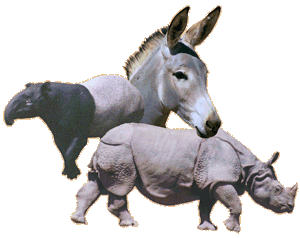 Perissodactyla, as we know it today, is a small
order of hoofed mammals, containing 17 Recent species in three families:
Equidae (horses), Tapiridae (tapirs), and Rhinocerotidae (rhinoceroses).
Despite being such a small order, the odd-toed ungulates have a wide
distribution, being found across the Ethiopian, Palearctic, Oriental, and
Neotropical zoogeographic regions. Two species have been domesticated - the
horse (Equus caballus) and the donkey (Equus asinus); feral
populations of these two species have been established across the globe,
(re)expanding this order's influence to the Nearctic and Australasian regions.
Perissodactyla, as we know it today, is a small
order of hoofed mammals, containing 17 Recent species in three families:
Equidae (horses), Tapiridae (tapirs), and Rhinocerotidae (rhinoceroses).
Despite being such a small order, the odd-toed ungulates have a wide
distribution, being found across the Ethiopian, Palearctic, Oriental, and
Neotropical zoogeographic regions. Two species have been domesticated - the
horse (Equus caballus) and the donkey (Equus asinus); feral
populations of these two species have been established across the globe,
(re)expanding this order's influence to the Nearctic and Australasian regions.
All modern perissodactyls are large to very large animals, ranging in size from the smallest equids (200 kg) to the largest rhinoceroses (3,500 kg). Despite the broad range in their physical appearances, perissodactyls are united by their mesaxonic limb structure, with most of the body weight being borne by the large central digit. Although a small order now, there are fourteen known families (living and extinct), which can be split into three suborders:
- Hippomorpha - horse-like perissodactyls.
- Ceratomorpha - rhinoceroses and relatives, including tapirs.
- Ancylopoda - the now-extinct chalicotheres.
Pe·ris·so·dac·ty·la
(pai'ris-oh dak ti'lah) |
Evolution
Diagnostic Characteristics
The skull is elongated, with the expansion occuring as a result of the facial bones being stretched (rather than the braincase). The nasal bones in the skull are expanded posteriorly, and project freely for at least part of their length. There is a well-developed paroccipital process. 'Horns' are present on the midline of the nasal and/or frontal bones in all living members of the Rhinocerotidae, but these are dermal in origin and have no bony core as in the artiodactyls. The dental formula is quite variable among modern species, I 0-3/0-3, C 0-1/0-1, P 3-4/3-4, M 3/3 x 2 = 24-44. In grazing species such as the horses the molars and premolars are hypsodont (high-crowned to allow for wear), while browsing forms such as the tapirs have brachydont (low-crowned) teeth. The pattern of dental ridges in modern perissodactyls is lophodont.
(From Norman and Ashley, 2000)
|
Equidae
|
or jump to the Perissodactyla Species List